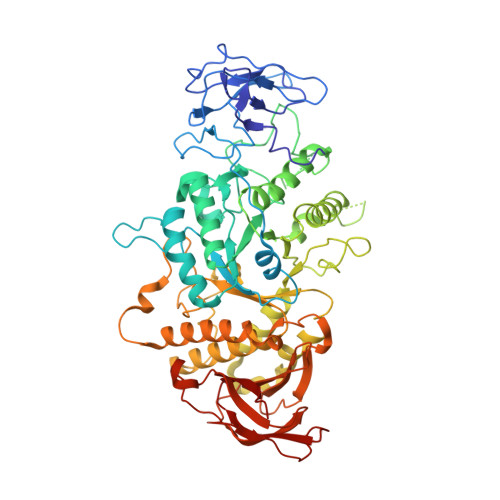Crystal structures of Escherichia coli branching enzyme in complex with cyclodextrins.
Feng, L., Fawaz, R., Hovde, S., Sheng, F., Nosrati, M., Geiger, J.H.(2016) Acta Crystallogr D Struct Biol 72: 641-647
- PubMed: 27139627
- DOI: https://doi.org/10.1107/S2059798316003272
- Primary Citation of Related Structures:
5E6Y, 5E6Z, 5E70 - PubMed Abstract:
Branching enzyme (BE) is responsible for the third step in glycogen/starch biosynthesis. It catalyzes the cleavage of α-1,4 glucan linkages and subsequent reattachment to form α-1,6 branch points. These branches are crucial to the final structure of glycogen and starch. The crystal structures of Escherichia coli BE (EcBE) in complex with α-, β- and γ-cyclodextrin were determined in order to better understand substrate binding. Four cyclodextrin-binding sites were identified in EcBE; they were all located on the surface of the enzyme, with none in the vicinity of the active site. While three of the sites were also identified as linear polysaccharide-binding sites, one of the sites is specific for cyclodextrins. In previous work three additional binding sites were identified as exclusively binding linear malto-oligosaccharides. Comparison of the binding sites shed light on this apparent specificity. Binding site IV is located in the carbohydrate-binding module 48 (CBM48) domain of EcBE and superimposes with the cyclodextrin-binding site found in the CBM48 domain of 5'-AMP-activated protein kinase (AMPK). Comparison of these sites shows the similarities and differences in the two binding modes. While some of the binding sites were found to be conserved between branching enzymes of different organisms, some are quite divergent, indicating both similarities and differences between oligosaccharide binding in branching enzymes from various sources.
- Department of Chemistry, Michigan State University, 578 South Shaw Lane, East Lansing, MI 48824, USA.
Organizational Affiliation:



















